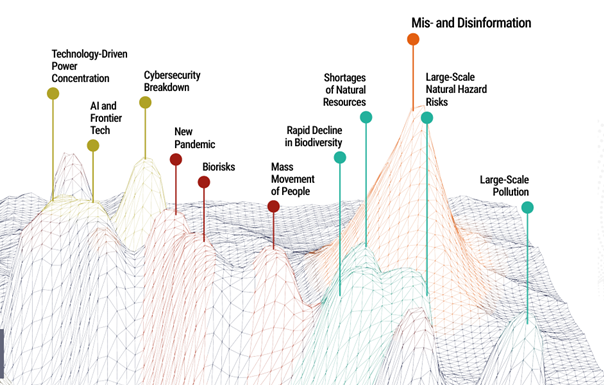Humanity is ‘risking catastrophe’: UN
July 16, 2025
The full spread of the impending crisis facing humanity is, at long last, emerging into daylight with the publication by the United Nations of its 2025 Global Risks Report.
The report describes a complex of 11 catastrophic threats now rapidly confronting humanity, all closely interlinked and which cannot be overcome without united, worldwide action.
The report was compiled from the views of 1100 “stakeholders” in industry, government, civil society and academia from 136 countries. It is a current consensus of global expert opinion on the human emergency.
It identifies 11 pressing risks in four realms of technology, society, environment and politics. Interestingly, it did not list the climate crisis among those risks. They are:

“We are living in an age of increasingly complex and interconnected global risks,” the report’s authors warn. “Multilateral institutions are not sufficiently prepared.” By which they clearly also mean “governments are not prepared” but are too diplomatic (or nervous) to say so.
The report’s five key findings are:
- “Global Vulnerabilities arise when institutions are underprepared for important risks; they cluster across political, technological, societal and environmental domains.
- “Many risks are already turning into crises: more than 80% of respondents identified mis- and disinformation, a top Global Vulnerability, as currently occurring.
- “Environmental risks are a priority across all regions: five of the top 10 most important risks are environmental.
- “Multi-government action is seen as the most effective response to mitigate global risks and overcome barriers like weak governance and lack of prioritisation.
- “Four future scenarios show how our joint action in confronting Global Vulnerabilities can lead to breakdown – or breakthroughs.”
The 2025 Report is the latest in a series, each identifying different risks and priorities for action according to informed perceptions at the time. They accord closely with the 10 catastrophic threats identified since 2020 by the Council for the Human Future as “the Human Emergency” based on global scientific data, notably its 2024 Roundtable Report on the Human Future, which warned: “The crisis is vast, complex and interconnected. It will affect everyone on Earth, for generations to come. There is at present no plan of action to resolve it, nor even a concerted effort to develop one.”
In the latest UN Report, the outstanding threat to humanity is mis/disinformation – the tsunami of lies now being spread by politicians, corporations and other vested interests to deceive society as to its true situation. (See _Pearls & Irritations_, March 2024) Awareness is slowly dawning that humans cannot survive if they do not understand the threats they face or how to overcome them.
This is evidenced in the US, whose citizens are now dying in ever-increasing numbers from misinformation spread by climate deniers, anti-vaxxers and pro-pollution lobbies in industry, politics and the general community. The fact that Americans now vote in tens of millions for dishonesty and politicians, corporations and the media have made lying a lucrative new industry, shows just how far the cancer has spread. Americans collectively no longer understand the world they live in and so are paralysed when it comes to taking rational decisions to protect themselves and their children. This fate awaits us all, as the torrent of falsehood swallows human societies round the planet, sped by AI, media, social media and the oil industry.
Unlike the Council for the Human Future, which bases its risk assessment on scientific analysis of the main threats to humanity, the UN Report is based on the opinions of its participants as to which threat is greatest at the present moment. Currently, the UN’s top risks do not include either climate change or weapons of mass destruction. This is not because these existential threats are small, but because current stakeholder opinion rates other risks more immediate. Clearly, opinion about which risk is greatest varies according to current perceptions of self-interest, not according to the good of humanity.
When it comes to solving the crisis, there is near unanimity among the UN’s interlocutors: multi-government action, joint action by government and civil society and by government and the private sector are the three top “solutions” being proposed. Yet they are far from being fulfilled. There is no Plan of Action to save humanity, as the Council for the Human Future has often pointed out – and no serious intent is yet evident on the part of the world’s governments to form one.
UN Secretary-General Antonio Guterres says: “Our future depends on global co-operation to address global risks. This report is a wake-up call and a blueprint. It shows us where we are most exposed and how we can and must renew multilateral co-operation. It urges us to move from crisis response to prevention, from fragmentation to foresight, from division to solidarity and resilience. We owe it to future generations to make that choice..”
But it is a message still falling on deaf ears and delusional minds: governments, it is plain, do not care whether their own nation and people exist in future or not, so long as they can cling to power in the short-term. The same is true of private industry – human survival is mostly seen as irrelevant to the immediate task of generating “shareholder value”.
The value of Global Risks 2025 lies in hammering home the message that the crisis now facing humanity is far larger, more complex and interlinked that we are willing to understand. A world full of parents simply does not seem to care whether the children survive or not. This is the hallmark of a species hell-bent on self-extinction.
Solutions exist aplenty – but are humans smart enough to adopt them, or to join hands to adopt them at global scale? “We owe it to future generations to make that choice,” says Guterres.
The views expressed in this article may or may not reflect those of Pearls and Irritations.
